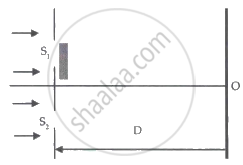Advertisements
Advertisements
Question
Explain why the maxima at `theta=(n+1/2)lambda/a` become weaker and weaker with increasing n
Solution
On increasing the value of n, the part of slit contributing to the maximum decreases. Hence, the maximum becomes weaker.
APPEARS IN
RELATED QUESTIONS
In the diffraction pattern due to a single slit of width 'd' with incident light of wavelength 'λ', at an angle of diffraction θ. the condition for first minimum is ....
(a)`lambda sin theta =d`
(b) `d costheta =lambda`
(c)`d sintheta=lambda`
(d) `lambda cos theta=d`
Describe briefly how a diffraction pattern is obtained on a screen due to a single narrow slit illuminated by a monochromatic source of light. Hence obtain the conditions for the angular width of secondary maxima and secondary minima.
Explain two types of diffraction of light.
In Fraunhofer diffraction, how is the angular width of the central bright fringe affected when slit separation is increased?
Monochromatic light of wavelength 4300 Å falls on a slit of width ‘a’. For what value of ‘a’ the first maximum falls at 30° ?
In a single slit diffraction experiment, how does the angular width of the central maxima change when:
- screen is moved away from the plane of the slit?
- width of the slit is increased?
- light of larger wavelength is used?
Wavelength of light of frequency 100 Hz is
Derive the expression for the angular position of (i) bright and (ii) dark fringes produced in a single slit diffraction.
In the diagram shown, the separation between the slit is equal to 3λ, where λ is the wavelength of the light incident on the plane of the slits. A thin film of thickness 3λ and refractive index 2 has been placed in the front of the upper slit. The distance of the central maxima on the screen from O is ______.

Draw a labelled graph showing the variation in intensity of diffracted light with diffracting angle in a single slit Fraunhofer diffraction experiment.
